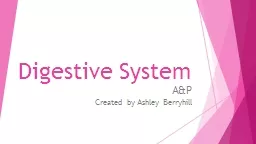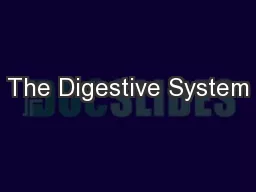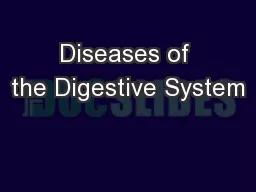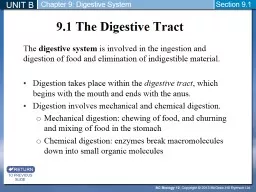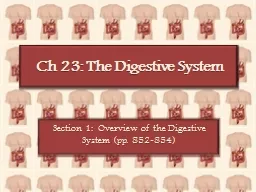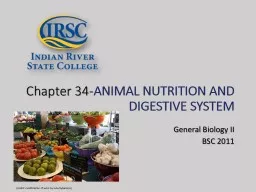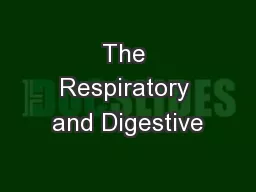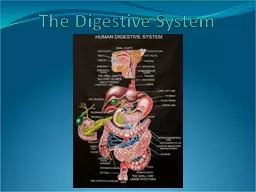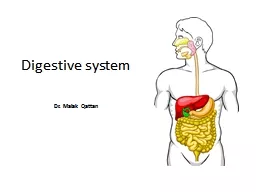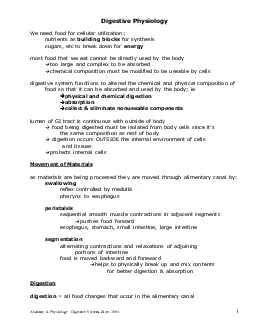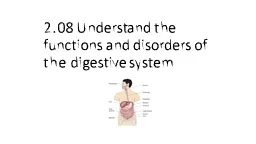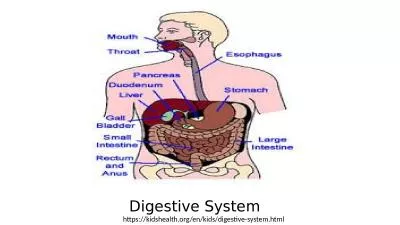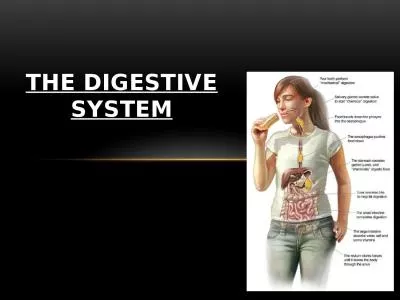PPT-Digestive System A&P
Author : fluenter | Published Date : 2020-06-17
Created by Ashley Berryhill Digestive System AKA gastrointestinal system or GI system Function responsible for the physical amp chemical breakdown of food so it
Presentation Embed Code
Download Presentation
Download Presentation The PPT/PDF document "Digestive System A&P" is the property of its rightful owner. Permission is granted to download and print the materials on this website for personal, non-commercial use only, and to display it on your personal computer provided you do not modify the materials and that you retain all copyright notices contained in the materials. By downloading content from our website, you accept the terms of this agreement.
Digestive System A&P: Transcript
Created by Ashley Berryhill Digestive System AKA gastrointestinal system or GI system Function responsible for the physical amp chemical breakdown of food so it can be taken into bloodstream amp be used by body cells amp tissues. . and Muscular. Systems . By Blandy , Esmeralda , Misty , Alexis , Idaly. Digestive system. The digestive tract (also known as the alimentary canal) is the system of organs within multicellular animals that takes in food, digests it to extract energy and nutrients, and expels the remaining waste.. Lesson5– . Digestive System Model. Objectives. :. Students will gain a full understanding of how the digestive and excretory system work in their own . bodies.. Students will be able to name the parts of the digestive system.. By Mr. Style. Parts of the Digestive System. The Mouth:. The . mouth is the beginning of the digestive system, and, in fact, digestion starts here before you even take the first bite of a meal. The smell of food triggers the salivary glands in your mouth to secrete saliva, causing your mouth to water. When you actually taste . A. Bacterial Diseases of the Upper Digestive Tract (Mouth & Stomach). 1. Tooth Decay (dental caries). A) This is an endogenous infection . 1) Most common infectious disease of humans . 2) Young are more susceptible than old. The . digestive system . is involved in the ingestion and digestion of food and elimination of indigestible material.. Digestion takes place within the . digestive tract. , which begins with the mouth and ends with the anus.. Section 1: Overview of the Digestive System (pp. 852-854). Two groups of organs. :. . 1) . Alimentary. canal. . - also known as . gastrointestinal. or . GI. tract. . - . digests. & . General Biology II. BSC 2011. Insert photo here representing. chapter. (credit: . modification of work by Julie Rybarczyk). Types of Digestive Systems. Heterotrophs are divided into three groups based on their food sources. Systems Key. I. The . Respiratory System. Define . respiratory system.. The system that functions to get oxygen from the environment and remove carbon dioxide and other waste products.. I. The Respiratory System. The digestive system is used for breaking down food into nutrients . which then pass into the circulatory system and are taken to where they are needed in the body.. Introduction. There . are four stages to food digestion:. . Qattan. 2. The GI tract. . (gastrointestinal tract). . Mouth. Pharynx. Esophagus. Stomach. Small intestine. Large intestine. Anus. The accessory digestive organs. Supply secretions contributing to the breakdown of food. pharynx to esophagus all food changes that occur in the alimentary canalAnatomy Physiology Digestive System Ziser 2003breaking large molecules proteins fats starches etca thick coating of bicarbona 2.08 Understand the functions and disorders of the digestive system. Essential questions. What are the functions of the digestive system?. How do the functions of chemical and physical digestion interrelate?. The digestive system has . three main . functions: . to convert food into nutrients your body . needs. Absorption. R. id . the body of . waste. To . do its job, the system requires the cooperation of a number of different structures and organs throughout the body, including the mouth, stomach, intestines, liver, pancreas and gallbladder.. Ingestion: . The in take of food into the digestive tract through the mouth. Mechanical Processing: . The physical manipulation of solid foods into materials that are easier to propel through the digestive tract. Also increases the solid foods surface area which makes them more susceptible to enzyme activity and easier to absorb. .
Download Document
Here is the link to download the presentation.
"Digestive System A&P"The content belongs to its owner. You may download and print it for personal use, without modification, and keep all copyright notices. By downloading, you agree to these terms.
Related Documents

